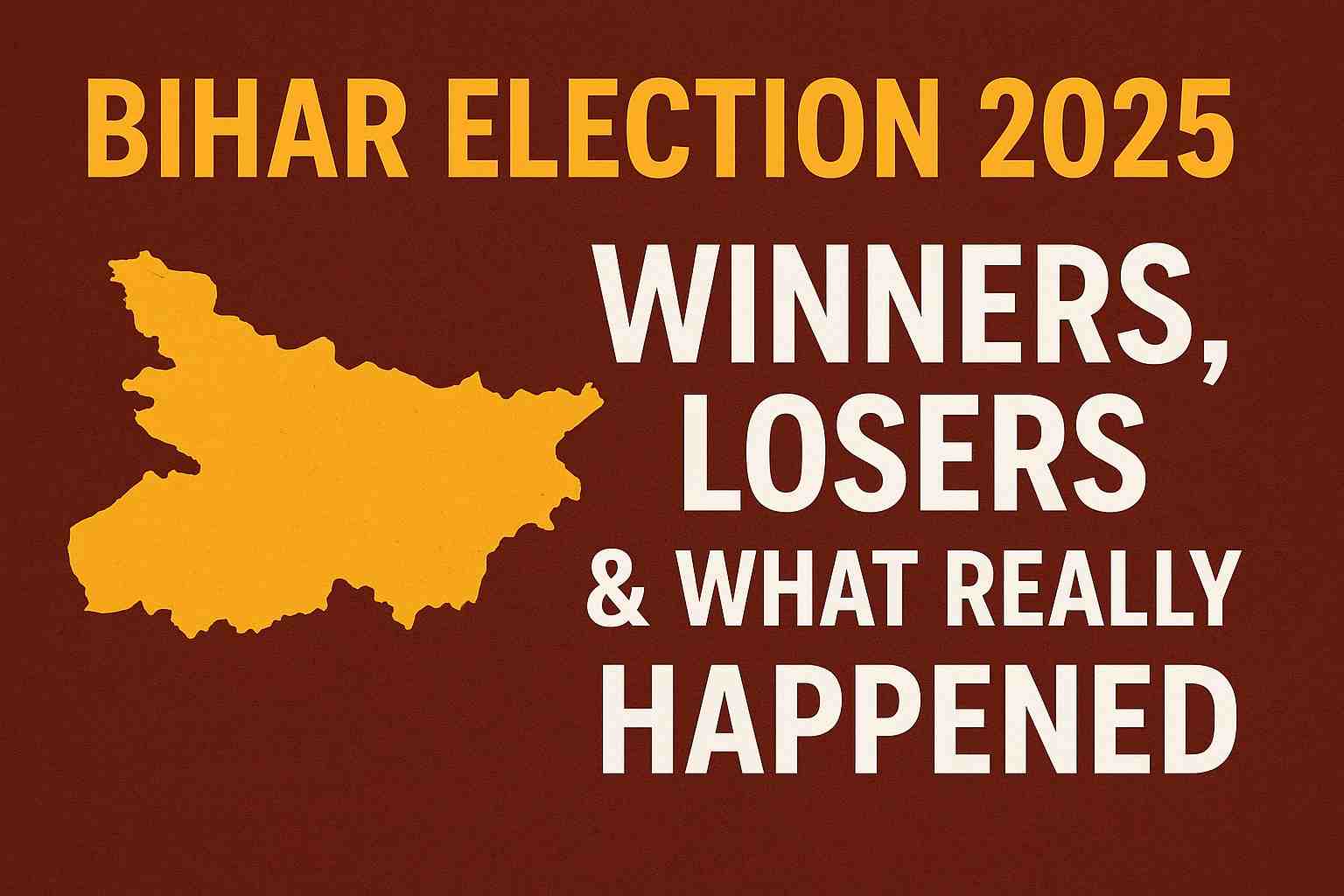Bihar Election 2025 – Top 10 Winners & Losers and What It Means
The Bihar Elections 2025 have delivered a dramatic verdict. The ruling National Democratic Alliance (NDA) has secured a decisive victory, reshaping the state’s political landscape. The results are not just about numbers—they reflect shifting voter dynamics, the power of women voters, and the changing fortunes of key leaders. According to reporting by The Times of India, here’s a breakdown of the biggest winners and losers of the poll.
Winners
1. Nitish Kumar
Nitish Kumar has emerged as the biggest winner of the election. Despite facing nearly two decades of incumbency pressure and voter fatigue, his party Janata Dal (United) (JD(U)), in alliance with the NDA, made gains in this election.
His ability to retain appeal — especially in a state marked by anti-incumbency sentiment — speaks to his political adaptability and strong grassroots network.
2. Narendra Modi
The victory further reinforces Prime Minister Narendra Modi’s personal appeal. The BJP’s success in Bihar owes a large part to his national leadership image and the transferability of his popularity across states.
His relevance and influence in regional polls remain strong, indicating that national leadership remains a key factor even in state elections.
3. Chirag Paswan
Chirag Paswan and his party (the Lok Jan Shakti Party) recorded a major turnaround. From a negligible performance in previous elections, they have secured a substantially better result this time around, showcasing the realignment of Dalit and younger voter blocs.
4. Women Voters
Women were arguably the silent but decisive winners of the Bihar polls. For the first time in the state, female voter turnout outpaced male turnout (72% vs 63%).
Schemes targeted at women’s welfare, self-help groups and panchayat empowerment played a major role in mobilising this electorate. Their voting behaviour tilted in favour of the government’s welfare and security narrative.
5. Asaduddin Owaisi (strategic winner)
While the All India Majlis‑e‑Ittehadul Muslimeen (AIMIM) may not have won a large number of seats, Owaisi emerges as a strategic winner — reinforcing his party’s influence in Muslim-dominated regions in Bihar, particularly Seemanchal.
This signals his growing relevance in the state’s political arithmetic.
Losers
6. Tejashwi Yadav
The election marks a significant setback for Tejashwi Yadav. Having led the Rashtriya Janata Dal (RJD) to 75 seats in the previous election, he entered this poll as the main challenger but failed to build on his momentum — the RJD is leading on only 29 seats in this cycle.
For a leader once seen as the future face of Bihar politics, this result dampens that narrative.
7. Rahul Gandhi
Despite high-profile campaigning and strategy efforts, the Indian National Congress saw no meaningful improvement in Bihar. Its seat tally remains dismal, reinforcing long-standing concerns about its relevance in the Hindi heartland.
8. Prashant Kishor
Once hailed as India’s top election strategist, Prashant Kishor’s own political ambitions did not translate into votes in Bihar. His party failed to gain traction despite significant media attention and ground effort.
9. Mukesh Sahani
Mukesh Sahani, the “Son of Mallah” who attempted to harness the Mallah–Nishad community vote and was positioned as a deputy-CM candidate, failed to convert caste appeal into seats. His repeated shifts in alliance may have damaged voter trust.
10. INDIA Bloc
The broad opposition alliance under the India bloc umbrella emerges as the biggest structural loser in Bihar. Disunity, weak coordination, seat-sharing conflicts and lack of a compelling narrative held them back from mounting a serious challenge.
Key Takeaways
-
Governance and welfare over identity? While caste and identity remain relevant, this election suggests that governance credentials, welfare schemes (especially those targeting women) and stability played a major role.
-
Women voters are changing the game. Their turnout and voting patterns are influencing outcomes significantly. Parties cannot ignore women’s welfare and empowerment if they want future success.
-
National leadership still matters. Even in state polls, national figures such as Narendra Modi influence outcomes, reinforcing the interplay between state-level and national politics.
-
Opposition must reinvent. For the INDIA Bloc, Congress, RJD, and other regional players, Bihar is a wake-up call — better strategy, message clarity and organisational coherence are needed.
-
Emerging players must consolidate. Gains by parties such as LJP under Chirag Paswan show emerging spaces in Bihar politics — but long-term growth will depend on sustainable organisation, local connect and credibility.
What this means for Bihar’s future
With the NDA dominating, Nitish Kumar’s government is likely to pursue an agenda focused on welfare expansion, women’s empowerment and consolidating its mandate. The strong performance sets the stage for the 2029 general elections, and parties will closely analyse Bihar’s outcome as a model for other states.
For opposition parties, the challenge will be rebuilding — engaging new voter segments, improving grassroots structures, and crafting messages that resonate beyond traditional vote banks.
Conclusion
The Bihar Election Results 2025 underscore the evolving dynamics of Indian state politics: voter behaviour is changing, women are emerging as a critical force, and the intersection of state and national politics is more visible than ever. The wins and losses here will ripple far beyond one state’s assembly.



